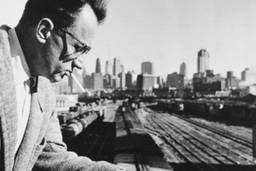
An important member of the middle class died in September. I went to his funeral. It was held at a Presbyterian Church in East Lansing, Mich., where we buried the ashes of Everett Ketchum, who, at 98 years old, may have been one of the last surviving participants of the Flint Sit-Down Strike of 1936-37.
Historians have credited the Sit-Down Strike as the natal event of the modern American labor movement — the British Broadcasting Corporation even dubbed it “the strike heard ‘round the world.” On Dec. 30, 1936, workers at General Motors’ Fisher 1 plant, fed up with arbitrary firings and a sped-up assembly line, put down their tools and occupied the factory. Ketchum was a 50-cent-an-hour apprentice, just beginning his career, and General Motors was the world’s largest corporation. But he signed on with the strike anyway, spending tense, idle nights on the shop floor playing euchre, watching movies or listening to speeches by United Auto Workers organizer Walter Reuther.
“My supervisor told me, he said, ‘Join it, Everett, you need it,’” Ketchum once told me. “We did, because you had nothing to stand on. The supervision, they had no control, either. You could come in to work today as a supervisor and have a desk and have a yellow slip on there that said, ‘You’re all done.’”
Even after a violent confrontation with local and company police that came to be known as the Battle of the Running Bulls, Michigan’s newly inaugurated New Deal governor, Frank Murphy, refused to order the National Guard to evict the strikers. GM was forced to negotiate. After 42 days, the company granted the workers a nickel an hour raise — and official recognition for the UAW.
That recognition led to the unionization of most American industries. As a result, working people have never been more prosperous than they were in 20th Century America. And I don’t know anyone who benefited more from that prosperity than Ketchum, who risked his nascent career to help win it.
As a craftsman who produced the dies that stamped out fenders, Ketchum belonged to the blue-collar elite. Skilled tradesman at GM was the best job in town. In 1950, Ketchum married a woman who worked at Michigan State University, and transferred to the Oldsmobile plant in Lansing. He used his night-shift bonus — a union perk — to buy houses near the MSU campus and rented them to students. Every two years, he bought a new Oldsmobile in cash, at an employee discount. When he retired in 1976, two years before the American auto industry hit its all-time high of 977,000 workers, Ketchum was earning $27 an hour— more than 50 times his starting wage.
Even in retirement, Ketchum was wealthy enough to spend $14,000 to repair the broken teeth of a waitress at his favorite diner, an act of generosity that earned him the nickname “Dental Man” from the local newspaper.
Ketchum collected GM retiree benefits for 37 years — almost as long as he worked for the company. When GM went bankrupt in 2008, retired tradesmen like him held on to their company health insurance — unlike the non-unionized salesmen and engineers. After the bankruptcy, I told him that his personal superannuation was probably responsible for the company’s financial crisis. He cackled at that, but he knew he was lucky, too.
“I really don’t know where I’d be if I didn’t have what I have,” he told me once, at the retirement home where he lived his last seven years. “If I had to buy my insurance that I got, I wouldn’t be living in this $2,000-a-month apartment. The whole picture, to me, [is that] I was in the right place at the right time. At GM, I [came] in there at a good time. It was just the right era for a lot of things, and I appreciate that.”
It’s impossible to imagine a modern factory worker following the same upward economic trajectory as Ketchum did. In its heyday, General Motors was nicknamed “Generous Motors,” for its high wages and benefits. Today, new hires start at $14 an hour — half the rate of longtime employees — and will retire with a 401K rather than a pension. Nationwide, union membership is down to 11.3 percent, its lowest level since Ketchum was 2 years old. Last year, the wealthiest 1 percent of Americans took in more than 19 percent of the nation’s income, their highest share since 1928. The causes for which Ketchum sat down in 1936 — collective bargaining, secure retirement, middle-class wages — enjoyed a half-century of success, but now seem like relics of another era, like the V-8 Rocket engine Oldsmobiles he used to build.
Ketchum’s life should not be forgotten, though, because it is a testament to what workers can gain when they stand up for their rights — and when the government stands with them, as it did during the Sit-Down Strike and for decades afterward. Opponents of this year’s fast-food strikes argued that workers at KFC and McDonald’s don’t deserve to earn more than $9 an hour, because they’re “unskilled.” One hundred years ago, that same argument was used to justify low wages for factory workers. Then those workers organized, and they claimed a fair share of their companies’ profits.
“The membership was so strong, they couldn’t do nothin’,” Ketchum recalled of the Sit-Down Strike. “In a way, it was kind of comical. General Motors, as big as they were, as strong as they were, they didn’t didn’t have a chance.”
That spirit shouldn’t die with the last of the Sit-Down Strikers.
The United Auto Workers are a sponsor of In These Times.





